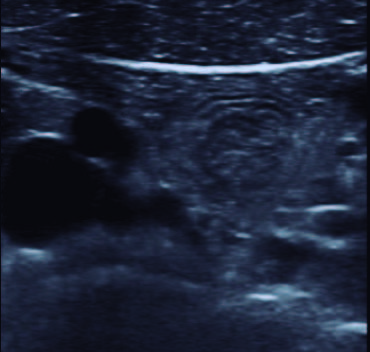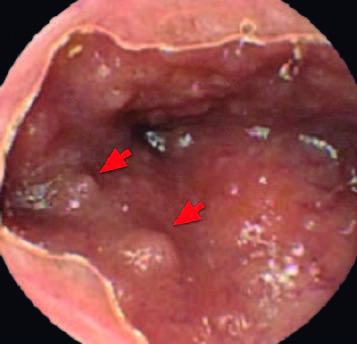A healthy 16-year-old male presented to the emergency department with vomiting and pain in the right iliac fossa for the previous 12 hours, with no other symptoms. On the physical examination the patient had pain in the right iliac fossa and localized rebound tenderness. Na abdominal ultrasound showed a small bowel intussusception with approximately 4.9 cm. Blood tests were normal, stool cultures and virology were negative. The intussusception reduced spontaneously in 24 hours. One week later the patient had the same complaints and a new abdominal ultrasound confirmed the recurrence of the intussusception (Fig. 1). The abdominal and pelvic computed tomography scan showed no other alterations.

Figure 1: Ultrassound transverse image of a target shaped lesion in the right iliac fossa, classical described as the “doughnut” or “target” sign, corresponding to the concentric rings of bowel Wall (inside the red square).
The intussusception reduced spontaneously. The investigation was negative for intestinal parasitosis, celiac disease and ectopic gastric mucosa. A video capsule endoscopy revealed small nodules in the distal ileum related to lymphoid hyperplasia (Fig. 2). After 2 years of follow-up, there were no signs of recurrence.

Figure 2: Video capsule endoscopy image showing small mucosa nodules (red arrows) in the terminal ileum, suggestive of nodular lymphoid hyperplasia
Intussusception is a common cause of intestinal obstruction in infants and children.1-3 In older children, especially adolescents, it is less frequent and has an atypical presentation in most cases.1,2 Although the majority of pediatric cases are idiopathic, in 25% a pathological lead point (PLP) can be determined, such as Meckel’s diverticulum, intestinal duplication, lymphoid hyperplasia, intestinal polyps, vascular malformations or malignancies.1,4 Clinical suspicion is extremely important at every age, since the delayed diagnosis may lead to intestinal ischemia, perforation and peritonitis.1,3
Recurrent intussusception occurs in approximately 10% of the cases. The risk factors have not been clearly defined, but older age (>1-2 years), absence of vomiting and PLP can be predictors of recurrent intussusception.3,5
Intestinal lymphoid hyperplasia is a benign condition and may act as a PLP for intussusception.4 A course of oral steroids may be used in cases of multiple recurrences; however, this approach needs more studies to be recommended.6















